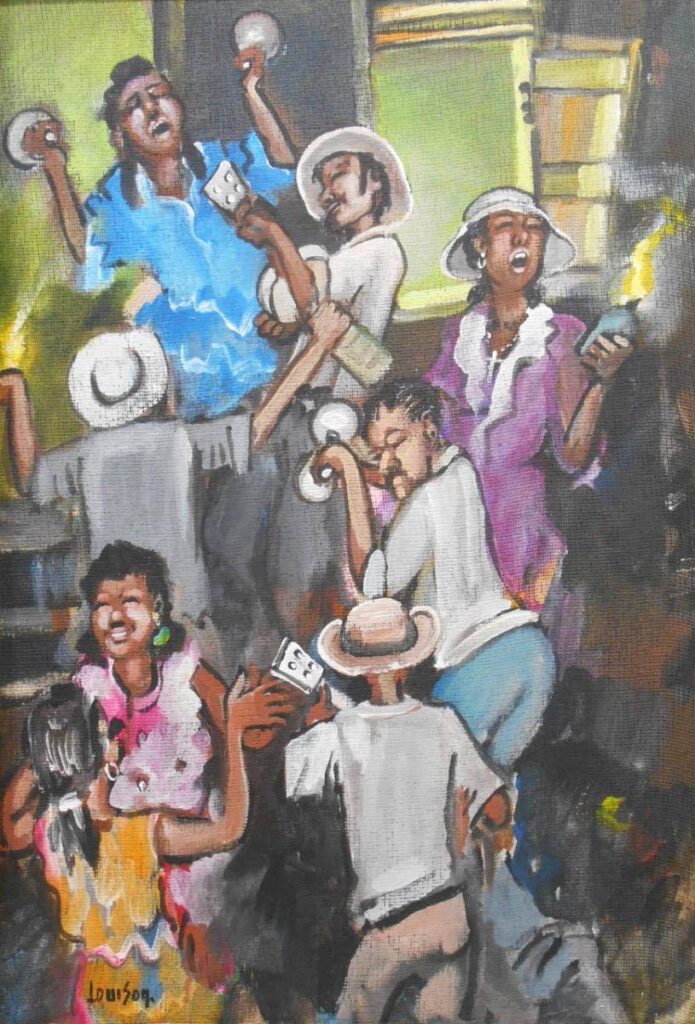Artist Dermot Louison dies at 89

Artist Dermot Louison has died at the age of 89.
His works, which portray slices of rural Trinidadian life, have inspired generations of artists.
A biography written for an exhibition at Horizons Art Gallery in Mucurapo said Louison was born into a middle-class family in Woodbrook in 1933, and spent his early childhood days in Cascade and St Ann’s, Port of Spain. He received his primary-school education at the St Ann’s RC School and his secondary education at the Tranquillity Government School.
He developed a strong interest in art at an early age, and largely self-taught, though he also attended the Sir John Cass School of Art in London from 1957-1959. During this time he travelled extensively in Europe.
Louison trained as an electrician at the United British Oilfields (UBOT, later Shell) from 1949-1955.
In 1956, he migrated to England on the Italian steamer Franca C (now the MV Doulos Phos) as part of the Windrush generation. He quit his job as an electrical engineer and began painting, with his first exhibition being at the Tate Gallery, London in 1958, exhibiting a portrait of Sir Winston Churchill.
In one of his later exhibition bios, Louison wrote, “I travelled to England in the 1950s as part of the hopeful #Windrush Generation. I found that life in London was not for me. I missed my hobbies as an open-air painter who painted while exploring the rain forests, villages and communities of my island, Trinidad. I also avidly did spear fishing during deep dives and hunted during the relevant seasons. My life among the poor classes of my island, coming out of colonialism, was inspiration to me to continue to record the culture of our Caribbean island.”
He developed into a professional artist after his return to Trinidad in 1959. He held many successful exhibitions both locally and within the Caribbean, and was an inspiration to many up- and-coming artists.
TT Art Society president Keiba Mottley said Louison had a large body of work produced over the years, which many upcoming and emerging artists were familiar with.
“Through his work he captured traditional and sometimes quintessential themes of TT that have always resonated really well with me, because it reminds me of my childhood and happy times. We can all be inspired by his work and his legacy.
"I didn’t meet him in person, I would have learned about him in art school, and more recently following his page on social media.”
Art Society immediate past president Peter Sheppard said Louison’s work depicted the lifestyle of TT.
“Through his work he captured or documented a way of life of our people in TT, through a very unique painting style which you could tell was his work. Similar to the American painter Norman Rockwell, he observed and documented the quirks of our daily lives. He captured the things that exist and existed, he captures rural landscapes, the modest houses that were built, their colours and hues, the things you find around the house, whether it’s a fowl in the yard, a KLIM tin with a plant in it, chickens or something, and that is something I also observe and paint in my paintings, and I admired that in his work.
“It’s important that artists have their mark. We’re physically here for a very short time, but we create work that lives on forever and tells a story that transcends generations. That’s the responsibility of the artist, and that’s a very fortunate responsibility to have, because who else is documenting these things we take for granted that bring us happiness and joy around our homes?”
Sheppard said Louison was supportive of other artists in that he would attend their exhibitions.
“It’s sad news when that light goes out, and we’re losing a lot of those lights in our visual and performing arts, and people just kind of go unnoticed. Louison has left his mark, and it’s a very significant mark, on our artistic landscape.”
Artist Jackie Hinkson said his memories of Louison date back to the 1950s, when he would go to the Public Library, now the Eric Williams Memorial Library, and see his works hanging on the wall.
“Decades later, in the 1970s, we would exhibit together at the Art Creators Gallery in St Ann’s, and we would chat when we met at the Deltex Art Shop in Pembroke Street.
"I generally noticed his pleasant quiet manner. He wasn’t fond of making himself a public scene at his exhibitions. I strongly suspect that it was because his life and experiences were inextricably intertwined with local things, hunting and fishing and country parlours, and that’s why he focused on that in his painting.
“I got the impression he knew a world different from the busy urban one and picked it, and that’s why in his work there’s this strong nostalgia for those days, that type of intimacy that was not strongly urban. He became extremely skilful at portraying those scenes of our lives, and that is why people loved his work.”
Louison’s work generally fell into the categories of sailing and marine vessels; landscapes and seascapes; country and village scenes; culture; people and figures; buildings and houses; portraits, drawings and illustrations; folklore; and commissioned works.
His work can be viewed at https://www.artpal.com/artemetagroup.


Comments
"Artist Dermot Louison dies at 89"